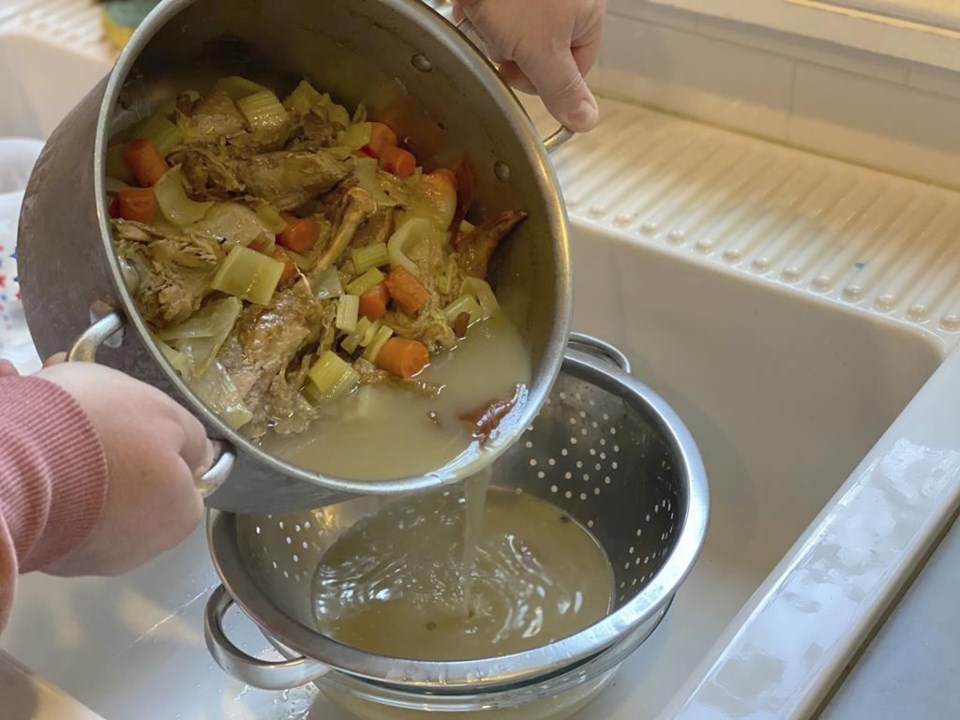Making turkey stock is a great way to use what you have on hand post-Thanksgiving. It's easy and economical: Almost all leftover parts of the bird can be put to use, including the bones, the skin, and small bits of meat attached to the carcass.
Just place them into a large soup pot with a generous amount of water. Add some basic vegetables and simmer away for at least an hour. Skim, strain, and you have stock.
The longer you simmer it, the more the stock reduces, becoming deeper and richer in flavor and slightly darker in color.
Anything but the giblets and the liver can be added to the pot. It's a less wasteful, more respectful way to enjoy meat. And these days, with inflation, we are all trying to stretch our food-buying dollars.
So buy that slightly larger-size turkey. When your house smells like Thanksgiving once again the next day, you can start to daydream about all of the ways you’ll put that stock to use.
Homemade stock will improve any soup, sauce and dish you use it in. While there are plenty of decent canned and boxed stocks and broth, nothing compares to the flavor of homemade. You can taste the freshness of the ingredients, even though they have been well-simmered and melded.
The vegetables used in stock can be as simple as onions, carrots and celery, maybe some fresh herbs. Or you can add a broader range of vegetables. If you’re a dedicated stock maker, keep vegetable scraps in a sturdy sealed bag in the freezer. Don’t overlook the stems of fresh herbs and peelings from various cleaned vegetables. Another smart economical kitchen practice.
Steer away from distinctively flavored vegetables like broccoli, asparagus or mushrooms, unless you are prepared for a potently flavored broth. Same for members of the cabbage family, like Brussels sprouts. Be thoughtful about adding garlic, which can overpower the flavor of the stock if used in large quantities. And red beets will affect the color in an obvious way!
Other ingredients can be added if you intend to use your stock in a particular way. An Asian-inspired stock benefits from the addition of fresh ginger or perhaps lemongrass, for instance.
Tips for Making Stock:
Don’t allow the stock to come to a boil. This can cause cloudiness, and also make it difficult to “defat” the stock later, as the fat will not congeal as well on top when cooled for easy removal. Keep the stock at a gentle simmer, with the bubbles slowly appearing at the surface.
Skim the stock as it simmers: Some foam will rise to the top and can be scooped out as it cooks. The foam isn't harmful, but skimming will result in a clearer stock with a cleaner flavor.
Defat or partially defat the stock. Once the stock is strained, allow it to cool completely and put it in the fridge. Once cold, the fat will have risen to the top and can be scooped off with a spoon. You may choose to leave a bit of the fat, which will make the stock richer when you reheat it. Note that homemade stock tends to thicken and become a bit gelatinous when it is chilled, but will liquify upon heating.
To reduce stock after it has been strained and defatted, reheat it in a large broad pot until it reaches your desired intensity and color. The wider the pot, the more quickly it will reduce. Reducing the stock concentrates the flavor.
TURKEY STOCK
Makes about 4 quarts
Ingredients:
Bones, leftover bits of meat, scraps and skin from 1 roasted turkey
6 carrots, scrubbed and cut into 1-inch pieces
8 celery stalks, cut into 1-inch pieces
1 large onion, unpeeled and quartered
2 bay leaves
1 cup dry white wine (optional)
1 tablespoon whole black peppercorns
1 teaspoon kosher salt, or to taste (see Note)
5 quarts cold water
Directions:
Place the turkey bones and all scraps into a large stockpot, big enough to hold them with some room to spare. Add the carrots, celery, onion, bay leaves, white wine (if using), peppercorns, salt and water into the pot. The water should cover the bones, or almost cover them, but it should be at least an inch below the top of the rim of the pot. Bring the water to a simmer over high heat, then reduce it immediately and keep the liquid gently simmering. Simmer for 1 to 2 hours, depending on how intense you want the stock to be. Press the bones down into the stock as it reduces, but it’s OK if the liquid lowers below the top of the turkey bones. Use a spoon to skim off any foam that rises to the top as the stock simmers.
Strain the stock through a colander or fine mesh sieve and discard the solids. Cool the stock, then place it in the fridge, either in a large pot or in quart containers. When the stock is chilled, scrape most or all of the fat from the top. Use as desired in various recipes. Turkey stock can be refrigerated for up to 4 days, or frozen for up to 4 months.
Note: If your turkey was brined or heavily salted, you may need less salt. Taste the broth when it is close to done. You can always add more salt towards the end!
___
Katie Workman writes regularly about food for The Associated Press. She has written two cookbooks focused on family-friendly cooking, “Dinner Solved!” and “The Mom 100 Cookbook.” She blogs at . She can be reached at [email protected].
Katie Workman, The Associated Press



